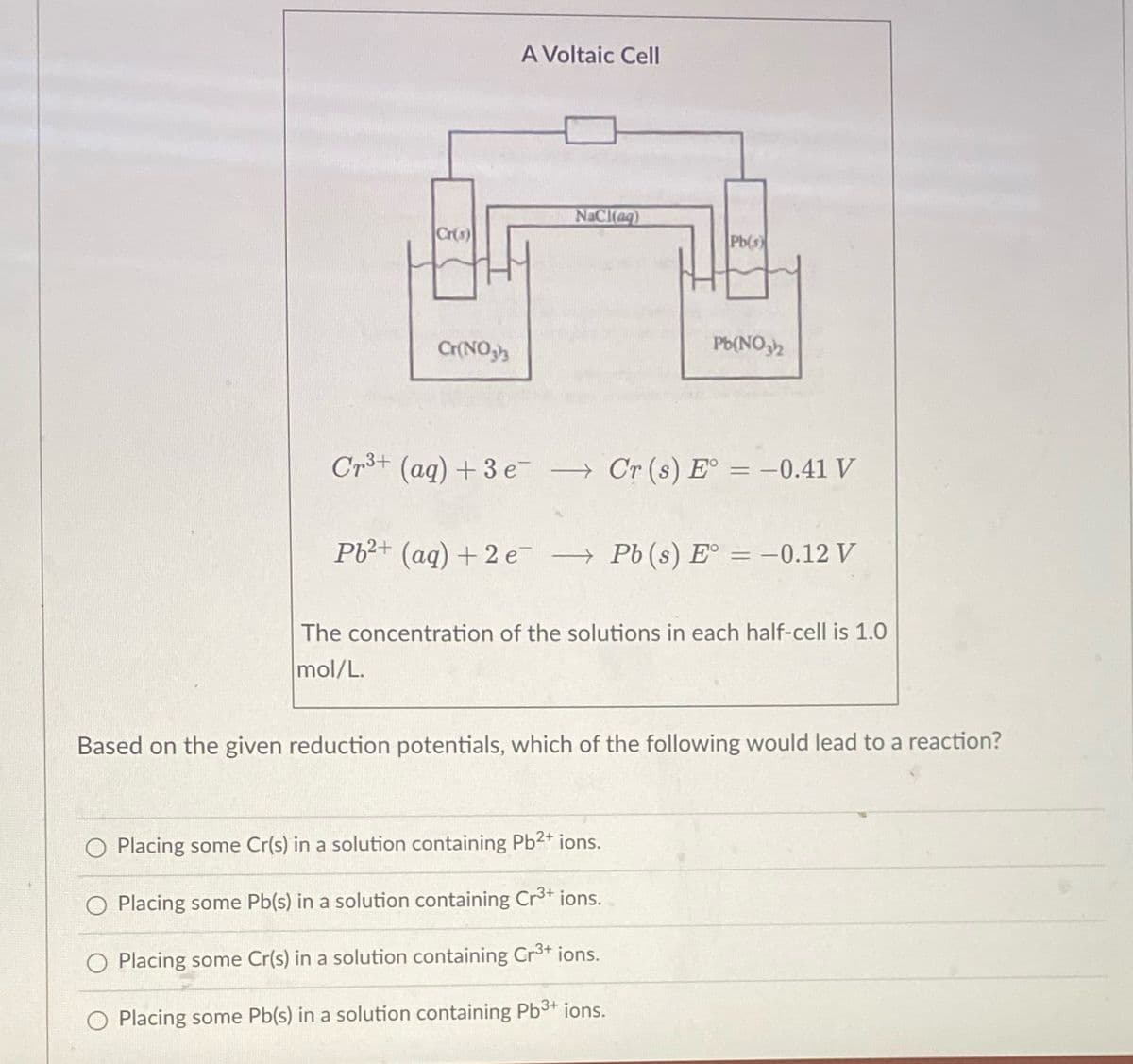Cr(s) Cr(NO3)3 Cr³+ (aq) + 3 e Pb²+ (aq) + 2 e NaCl(aq) Pb(s) Pb(NO32 → Cr (s) E° = -0.41 V → Pb (s) E° = -0.12 V The concentration of the solutions in each half-cell is 1.0 mol/L. Placing some Cr(s) in a solution containing Pb²+ ions. Placing some Pb(s) in a solution containing Cr³+ ions. Placing some Cr(s) in a solution containing Cr³+ ions. Placing some Pb(s) in a solution containing Pb3+ ions. Based on the given reduction potentials, which of the following would lead to a reaction?
Cr(s) Cr(NO3)3 Cr³+ (aq) + 3 e Pb²+ (aq) + 2 e NaCl(aq) Pb(s) Pb(NO32 → Cr (s) E° = -0.41 V → Pb (s) E° = -0.12 V The concentration of the solutions in each half-cell is 1.0 mol/L. Placing some Cr(s) in a solution containing Pb²+ ions. Placing some Pb(s) in a solution containing Cr³+ ions. Placing some Cr(s) in a solution containing Cr³+ ions. Placing some Pb(s) in a solution containing Pb3+ ions. Based on the given reduction potentials, which of the following would lead to a reaction?
Chemistry: The Molecular Science
5th Edition
ISBN:9781285199047
Author:John W. Moore, Conrad L. Stanitski
Publisher:John W. Moore, Conrad L. Stanitski
Chapter17: Electrochemistry And Its Applications
Section: Chapter Questions
Problem 22QRT
Related questions
Question
give explanation for correct and incorrect option plz with detail explanation

Transcribed Image Text:Cr(s)
Cr(NO3)3
A Voltaic Cell
NaCl(aq)
Pb(s)
Pb(NO3)2
Cr³+ (aq) + 3 eCr (s) E° = -0.41 V
Pb²+ (aq) + 2 e¯¯ → Pb (s) E° = -0.12 V
The concentration of the solutions in each half-cell is 1.0
mol/L.
Placing some Cr(s) in a solution containing Pb2+ ions.
Placing some Pb(s) in a solution containing Cr³+ ions.
O Placing some Cr(s) in a solution containing Cr³+ ions.
O Placing some Pb(s) in a solution containing Pb³+ ions.
Based on the given reduction potentials, which of the following would lead to a reaction?
Expert Solution
This question has been solved!
Explore an expertly crafted, step-by-step solution for a thorough understanding of key concepts.
Step by step
Solved in 3 steps

Knowledge Booster
Learn more about
Need a deep-dive on the concept behind this application? Look no further. Learn more about this topic, chemistry and related others by exploring similar questions and additional content below.Recommended textbooks for you

Chemistry: The Molecular Science
Chemistry
ISBN:
9781285199047
Author:
John W. Moore, Conrad L. Stanitski
Publisher:
Cengage Learning

Chemistry by OpenStax (2015-05-04)
Chemistry
ISBN:
9781938168390
Author:
Klaus Theopold, Richard H Langley, Paul Flowers, William R. Robinson, Mark Blaser
Publisher:
OpenStax

Chemistry
Chemistry
ISBN:
9781305957404
Author:
Steven S. Zumdahl, Susan A. Zumdahl, Donald J. DeCoste
Publisher:
Cengage Learning

Chemistry: The Molecular Science
Chemistry
ISBN:
9781285199047
Author:
John W. Moore, Conrad L. Stanitski
Publisher:
Cengage Learning

Chemistry by OpenStax (2015-05-04)
Chemistry
ISBN:
9781938168390
Author:
Klaus Theopold, Richard H Langley, Paul Flowers, William R. Robinson, Mark Blaser
Publisher:
OpenStax

Chemistry
Chemistry
ISBN:
9781305957404
Author:
Steven S. Zumdahl, Susan A. Zumdahl, Donald J. DeCoste
Publisher:
Cengage Learning


Chemistry: An Atoms First Approach
Chemistry
ISBN:
9781305079243
Author:
Steven S. Zumdahl, Susan A. Zumdahl
Publisher:
Cengage Learning

Chemistry & Chemical Reactivity
Chemistry
ISBN:
9781337399074
Author:
John C. Kotz, Paul M. Treichel, John Townsend, David Treichel
Publisher:
Cengage Learning